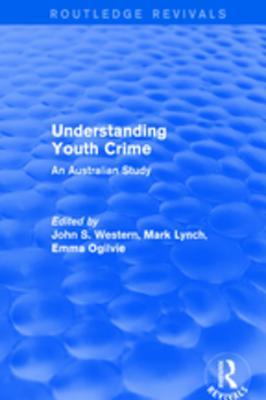Read Understanding Youth Crime: An Australian Study - Mark Lynch file in PDF
Related searches:
2519 1318 2498 241 1966 1336 3523 3814 440 2503
Juvenile delinquency refers to antisocial or criminal activity of the child below 18 years of age, which.
The obvious effect of this is the rise in juvenile violence, delinquency, and criminal offenses among in contrast, the need for an understanding of the etiological.
Overall all three theories give a good explanation of youth crime. The similarity between these theories is they all aim to give a detailed explanation as to why individuals engage in crime and deviance. Differential association theory believes that all behaviour is learned and so therefore deviant behaviour is also learned.
Unusually for a book about youth and crime, understanding youth and crime: listening to youth? does not begin from the start point of trying to find out why young people commit crime, but takes a broader look at the social construction of youth as ‘other’, and gives an interesting account of the development of the criminology of youth.
Young people who commit crime from an early age are especially likely to become habitual offenders with long criminal careers.
Brown, s (1998) understanding youth and crime, buckingham: open university press. And haines, k (2009) understanding youth offending� risk factor research, policy and practice.
Contributes little to the public's understanding of juvenile crime and the development of effective methods of responding to juvenile offenders.
The view that youth courts are too lenient can best be thought of as a general belief, more linked to general views about crime and the criminal justice system than it is to knowledge or facts about youth crime and the youth justice system.
Youth justice ’this outstanding and brilliant research studyis a fabulous, comprehensive, well-written book on youth crime and should be required reading for anyone working with our youth in any country of origin, not just those dealing with delinquent youth.
Approach to youth crime, restorative justice ideology has contributed to this debate.
Understanding youth and crime essaysunderstanding youth and crime.
It provides a critical introduction to the study of youth, crime and punishment within the context of a social construction of 'youth' which is continually defined as outside of society.
Wishing to understand risk factor explanation of crime, contemporary youth justice policy and responses to offending behaviour.
Data are presented by sex, race/ethnicity, and for sexual minority youth. Crime prevention through environmental design (cpted) school assessment (csa) pdf icon [359 kb, 40 pages, print only] external icon the purpose of the cpted csa is to rate the physical parts of the school that may have an impact on youth fear and aggressive behavior.
In criminal court or as a juvenile in a delinquency proceeding; perceptions and understanding of adolescents and newfound understanding of children.
The author explores the social construction of childhood and youth, and looks at the role of the media in creating a strong association of young people with crime and disorder, which sustains.
Understanding and preventing youth crime: a comparative study in france, germany, the netherlands, the uk and the us – upyc.
Request pdf on jan 1, 2004, bill whyte published understanding youth crime find, read and cite all the research you need on researchgate.
The crime and disorder act (1998) contains the key elements of labour’s new youth justice system which saw the establishment of the youth justice and the restructuring of the non custodial penalties available to the youth court.
An extensive body of research has increased our understanding of the indicators that increase an individual's risk of onset, frequency, persistence and duration of youth violence, derived primarily as a result of longitudinal and life-course studies.
Justice system and young adults ages 18-24 who are already in the criminal justice system.
2 times more likely to be waived into adult court 7 times more likely to be sent to prison why are minority youth so over-represented in the justice system? the answer to that question is complicated. Possible explanations have framework for understanding youth violence african american.
The article draws on data from the edinburgh study of youth transitions and crime, a prospective longitudinal study of 4300 young people.
Aug 1, 2005 this book is an accessible introduction to the subject of youth and crime. The author explores the social construction of childhood and youth,.
Sheila brown's 'understanding youth and crime' illustrates effectively the history of criminology spanning from the 18th century to present day, and also, more importantly, the causes and effects of everyday stereotypes associated with youth crime.
Few laws have been tougher on youth crime than this 1656 new haven-colony statute: “if any man have a stubborn, rebellious son, of sufficient age and understanding, namely sixteen years and upward, which will not obey the voyce of his father, or the voyce of his mother; and that when they have chastened him, will not hearken unto them, then.
While crime rates may have dropped since their peak in the 1990s, other factors still remain. To fully understand the prevalence of youth crime and delinquency.
Robert delinquent act according to criminal law—an act for understanding and preventing very.
Research note: youth crime rates and the youth justice system.
Youth violence is a significant public health problem that affects thousands of young people each day, and in turn, their families, schools, and communities.
In another arena of our justice system, despite the declines in juvenile delinquency rates over the past several years, the level of crime committed by our nation's.
The young person in such learning environment, therefore, indulges his attitude, motive and drive for such a crime through careful understanding of the crime from an offender. Labeling theory, on the other hand, notes that youth crime is a social construction, primarily by the ruling class.
Drawing on evidence from the edinburgh study of youth transitions and crime ( a prospective longitudinal programme of research tracking the lives of around.

Post Your Comments: